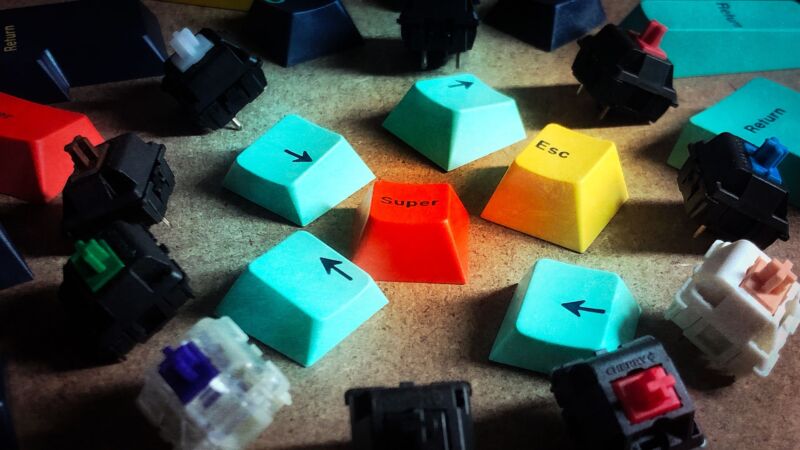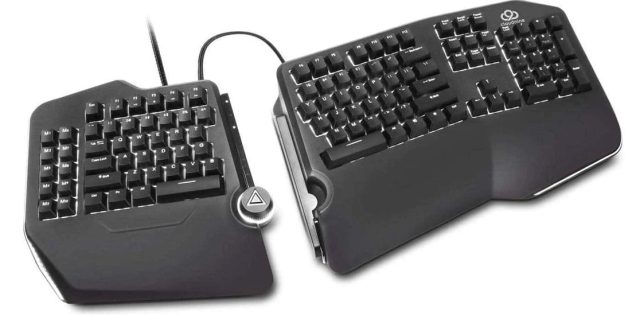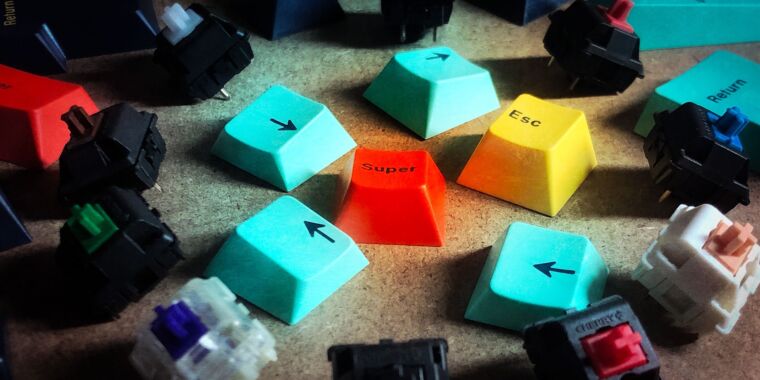
Aurich Lawson
So you’ve heard about mechanical keyboards and you want to learn more.
Sure, a standard membrane keyboard will get the job done, but the long-lasting keys and trademark tactile responsiveness of mechanical keyboards offer a premium experience that many people swear by. If you’ve ever remarked with dismay about a keyboard’s “mushiness,” a mechanical keyboard might be just the thing you need.
Every key in a mechanical keyboard has its own switch, and registering an input requires pushing a plastic stem inside the switch down, with resistance coming from the switch’s spring. In contrast, membrane keyboards (also known as rubber dome keyboards) use thin layers of plastic underneath the keys. Pressing a key sends a dome-shaped piece through a hole in the membrane, creating a circuit and sending an input to the PC. While membrane keyboards are typically thinner, quieter, more spill-resistant, and cheaper to make, they can feel flat and make it difficult to know if you’ve pressed a key or not. Mechanical switches offer way more physical feedback.
That’s not surprising, considering the fact that mechanical keyboards are close descendants of typewriters, delivering a signature, affirmative tactility with each keypress. IBM’s buckling spring switch, patented in 1977, largely laid out the foundation for today’s mechanical switches. And in the 1980s, the company Cherry patented its first mechanical switches, introducing different types of feel and travel that are still used, imitated, and reimagined today.
But buying a mechanical keyboard isn’t so simple. There are different sizes, switches, keycaps, and features. Not to mention the jargon—what do half of these words even mean? It’s enough to make even the most determined shopper give up.
Whether you need a primer, a refresher, or a handy reference to show to interested newbies, we’re here to help. Below, we break down what you should know before buying a mechanical keyboard.
Let’s get clacking.
Mechanical keyboard sizes
The first thing to determine is what size keyboard you want.
You may consider a smaller keyboard if you have limited desk space, want extra room for your mouse, need something portable, or just prefer a cleaner look. Some enthusiasts claim that a smaller keyboard helps provide a more ergonomic fit because you can keep your arms closer to your body while using all the keys.
Some keyboards take liberties with the traditional layouts. And you can find niche products in between, such as a “50 percent keyboard.” When in doubt, you can look at pictures to ensure a keyboard has the keys you need.
Here’s a quick rundown of the most common mechanical keyboard sizes.
-
The Asus ROG Claymore II is a full-sized keyboard with a detachable numpad.
-
The Logitech G915 TKL is an 80% keyboard.
-
Glorious’ GMMK Pro is a 75% keyboard with a volume knob.
-
The Keychron Q2 has a 65% layout, plus a rotary knob.
Scharon Harding -
The Anne Pro 2 is a 60% keyboard.
-
Vortex’s Core 40% keyboard.
- Full-size: All the keys, including the function row and numpad. Number crunchers will want a numpad, but note that you can also buy a separate mechanical numpad or a mechanical keyboard with a detachable numpad.
- Tenkeyless / TKL / 80%: All the keys except the numpad
- 75%: All the keys except the numpad and some of the navigation cluster. Arrows are present.
- 65%: All the keys except the numpad, some of the navigation cluster, and the function row. Arrows are present.
- 60%: All the keys except the numpad, all of the navigation cluster, and the function row. No arrows.
- 40%: All the keys except the numpad, navigation cluster, function row, number row, and some punctuation marks. They often have a split spacebar, letting that area serve as two separate keys.
Some smaller keyboards with truncated layouts have keys that register a different input when you hold down another key (often Fn). You may have to memorize these secondary, tertiary, and quaternary layers. Other keyboards make accessing these functions easier by printing smaller secondary legends on the bottom edge of the corresponding keycaps.

Keep an eye out for ergonomic options. Also known as split keyboards, ergonomic keyboards split the keyboard in two so you can keep one side closer to each hand’s natural position when sitting at your desk. Split keyboards come with a learning curve, and you can get them in various designs to accommodate for comfort and different inputs.








